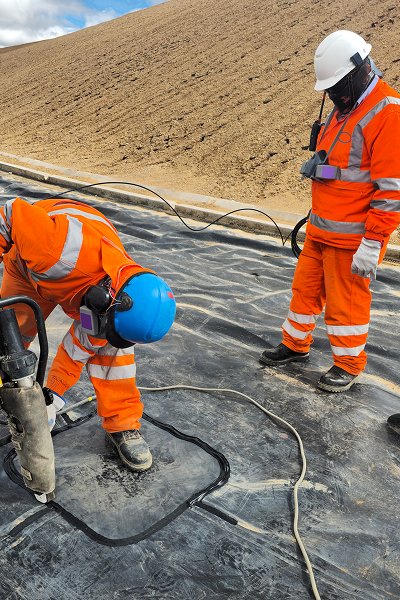Geomembrane thickness classification
Thin membrane (0.2mm - 0.5mm): used for temporary covering, short-term closure, etc.;
Medium thickness membrane (0.75mm - 1.5mm): widely used in landfills, water conservancy projects, sewage pools;
Thick membrane (≥2.0mm): used for high-strength, hi
gh-corrosion, and high-demand projects, such as hazardous waste landfills, petrochemical pool linings, etc.


Analysis of thickness on geomembrane performance
Tensile strength and elongation performance
The thickness of geomembrane has a strong positive correlation with its tensile strength. The thicker the membrane, the higher the structural density of the material per unit area, and the stronger the overall ability to resist external tensile force.
Thick membrane (≥1.5mm): has higher breaking strength and is suitable for high-load environments;
Thin membrane (≤0.5mm): has good flexibility, but weak tensile properties, and is not suitable for long-term high-stress areas.
Puncture resistance
Geomembranes may be punctured by sharp stones, protruding foundations or construction machinery during installation. The thicker the membrane, the more effective it is in preventing damage caused by these factors:
1.5mm and above membranes: suitable for environments with many sharp objects and heavy mechanical loads such as landfills and mining areas;
≤0.5mm membranes: suitable for laying on fine soft cushions or temporary projects, and must be used with a protective layer.
Anti-seepage performance and water vapor barrier ability
The anti-seepage mechanism of geomembrane comes from its continuous and dense structure. The thicker the thickness, the longer the intermolecular path, the stronger the barrier to water molecules, and the lower the permeability. Specifically:
Thick film can significantly reduce the long-term permeation rate, which is particularly important when the hydrostatic pressure is large and the organic matter in the liquid is complex;
The film can meet the basic anti-seepage needs in short-term projects, but it is not suitable for environments with corrosive or durability requirements.
Specific requirements of the project for geomembrane thickness
Landfill
Recommended thickness: ≥1.5mm HDPE membrane (2.0mm recommended)
Cause analysis:
Facing long-term biochemical corrosion (leachate contains heavy metals, acid and alkali, etc.);
Requires extremely high anti-seepage and puncture resistance;
Multi-layer composite system structure, high requirements for base membrane strength;
Usually requires a service life of at least 30 years.

Water reservoir and channel anti-seepage
Recommended thickness: 1.0mm~1.5mm (LLDPE or HDPE)
Reason analysis:
Long-term water pressure requires good anti-seepage performance;
Most projects are exposed to the natural environment and need to be UV-resistant;
Flexibility and thermal expansion and contraction capabilities are also required (LLDPE has stronger adaptability);
Additional thickness or composite reinforcement is required for slope areas.

Agricultural ponds/fish ponds/aquaculture ponds
Recommended thickness: 0.5mm~1.0mm LDPE or LLDPE film
Reason analysis:
Easy construction and controllable cost;
Generally used temporarily or for a short period of time;
Requires non-toxic and environmentally friendly materials to ensure water safety.

Other key factors affecting thickness selection
Foundation conditions: Soft soil or sharp objects require thicker membrane or composite protective layer;
Load and filler pressure: Thickness needs to be coordinated with backfill load;
UV exposure degree: It is recommended to thicken for exposed projects to extend service life;
Budget cost: Performance and cost need to be balanced;
Construction equipment and welding method: Too thin may be easy to damage, too thick is not easy to construct.
Protecting Thickness-Sensitive Areas During Installation
| Critical Area | Potential Risk | Protection Measure |
|---|---|---|
| Anchor trenches & corners | Folding, tearing, abrasion | Use cushioning geotextile; lay in smooth curves |
| Slope transitions | Lifting seams, membrane stress | Allow enough slack, avoid pulling too tight |
| Overlap/weld zones | Uneven thickness, weak welding | Maintain ≥10 cm overlap, clean and grind before welding |
| High-traffic areas | Compaction, surface damage | Use temporary wooden planks for walkways |
Early Warning Signs of Thickness-Related Failures
| Warning Sign | Possible Cause | Suggested Solution |
|---|---|---|
| Local deformation | Uneven subgrade or insufficient thickness | Add cushioning geotextile; replace with thicker membrane |
| Seam swelling | Inappropriate weld settings for thickness | Re-weld with corrected parameters |
| Frequent damage during handling | Rough transport or thin material | Improve handling standards; upgrade thickness |
| Seepage detected downstream | Membrane tear or seam failure | Excavate area, inspect and repair |
The thickness of geomembrane should not be chosen as "the thicker the better", but it should be adapted to local conditions, combined with the project environment, service life, budget and construction feasibility, to formulate a scientific and reasonable thickness matching plan. It is hoped that this article can provide a systematic reference for the planning, design and implementation of various anti-seepage projects, and truly achieve the unity of reliability and economy of anti-seepage effect.


